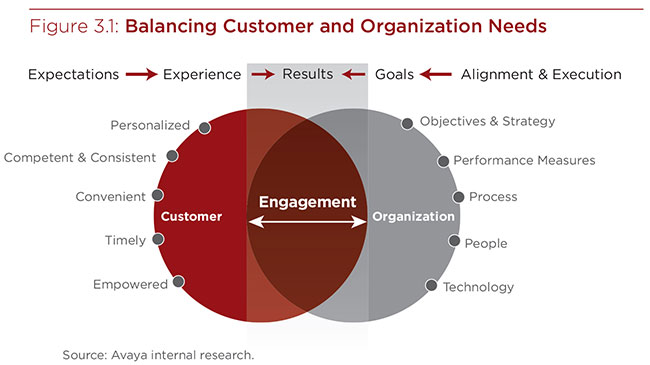
Though customer service logically falls on the shoulders of the customer service department, customer experience management (CEM) is only fully successful if implemented holistically across the entire organization. Senior management, contact center personnel, line-of-business leaders, IT staff, and subject matter experts must all be involved. In order to close the gap between customers’ expectations and the service that they receive, strategies must be defined, processes integrated, people empowered, and technologies adopted.
Businesses recognize that delivering the right customer experience is a smart differentiator in a cost-conscious, economically pressured, commoditized market. According to Forrester/CustomerThink’s Global Service TechRadar Online Survey conducted in May 2011, 40 percent of respondents cited improving the customer experience as their top customer service goal. Another 40 percent said that it was their second most important goal, and 21 percent said it was their third most important goal. It’s not just customer experience in general; the survey highlighted the growing importance of improving the online customer experience.
Organizations struggle, however, to meet expectations—and additional channels add complexity to the mix. For example, they have a hard time with:
Supporting multiple media types such as phone, help/FAQs pages, email, chat, SMS/text, and social media.
Providing agents with a full view of customer interactions to support customers’ expectations of a seamless transition from one media type to the next—without having to restart the conversation from the beginning.
Communicating with customers based on insight into the customer need and appropriate contextual data. Agents often lack full access to customer data across the organization. For example, they may not know that a mortgage customer also has a credit card with the company, or they may struggle to find the right information across multiple disconnected systems.
Facilitating collaboration between agents and specialized agents, leaders, and subject matter experts.
Choosing the right metrics to measure performance. For example, agents may be rewarded for speed of answer and call handle times rather than how effectively they resolved a customer’s inquiry, even though the latter is vital to the customer experience.
These challenges are noticed by customers, who aren’t impressed with modern service levels as a whole. According to Forrester Research, only 37 percent of companies earned an excellent or good Customer Experience Index rating from consumers in 2012. Businesses such as banks, Internet service providers, and health insurance companies had the largest gaps between their highest and lowest scores.
By focusing on improving the customer experience, companies can reap quantifiable business results. This requires a holistic approach, taking both the customer and organization into account. (See Figure 3.1.) Companies must understand the customers’ needs and requirements and align those needs to their organization. They must also define a customer experience strategy, standardize processes across channels and the organization as a whole, cultivate a culture of service and empowerment, and choose the right technologies to accomplish all of the above—all while never losing focus on doing what’s right for the customer.
This includes addressing the following organization considerations:
Objectives and strategy. Defining a customer experience strategy involves identifying the customers the company intends to serve, the experience their customers expect the organization to deliver, and the media types and touchpoints that will be affected.
Processes. Standardizing and integrating processes for all customer-facing personnel across all supported media types ensures a more consistent customer experience. These processes must also be agile in order to support a business’s changing needs.
People management. Cultivating a culture of service, empowerment, and collaboration across the organization is vital to improving customer satisfaction. This involves re-examining and refining leadership practices, collaboration methods, training programs, and performance measurement approaches.
Performance measures. Identifying and measuring the right metrics is critical to ensuring that both the customer’s and organization’s requirements are being addressed successfully. This could mean that new metrics need to be introduced and old metrics revamped.
Technology. Choosing the right technologies is crucial. Integrated contact center technologies can enable the optimal customer experience across media types while providing agents with the context that they need to work more effectively, collaborate with leaders and subject matter experts, and personalize the interaction.
When an organization successfully aligns its strategies and tactics with customers’ expectations, a positive customer experience is the result. This in turn leads to improved advocacy, loyalty, and retention rates and reduced service costs—all important success factors in raising customer lifetime value.

